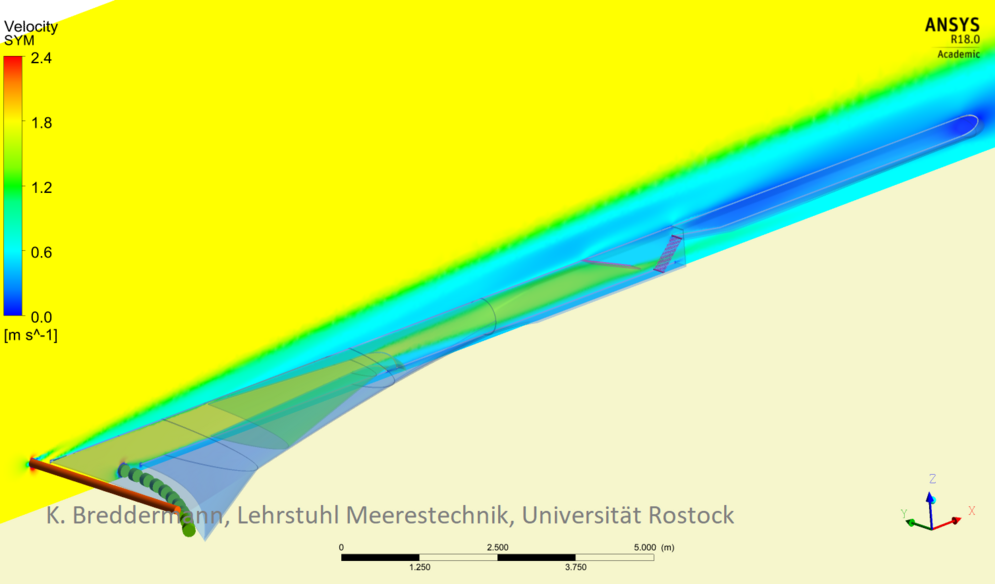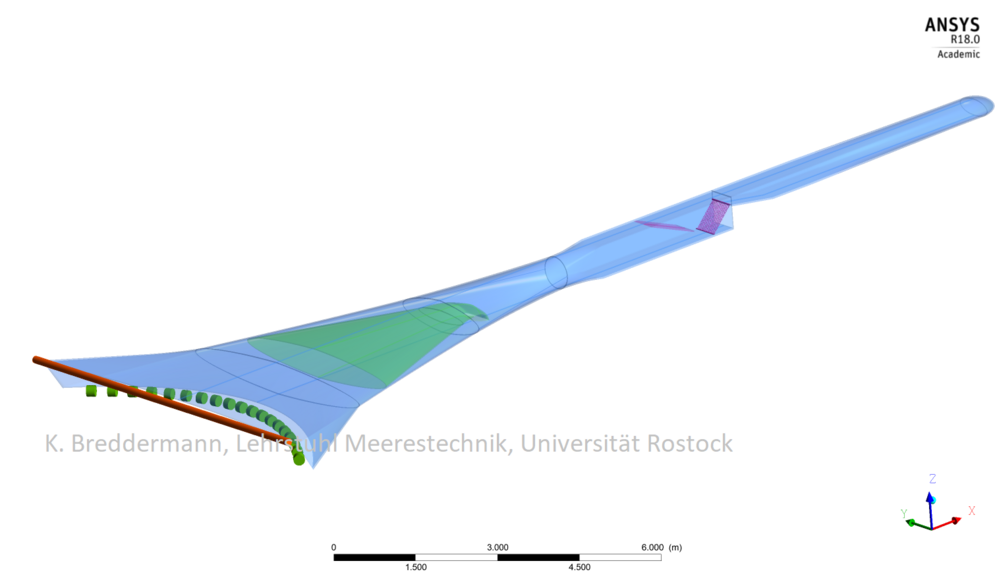Project
A tool for fishing gear optimisation (SimuNet)

SimuNet - A tool for fishing gear optimisation
For the development of innovative and sustainable fishing gear, we are working together with the University of Rostock on a software tool to simulate the hydrodynamics and deformation of nets.
Background and Objective
Through the European Maritime and Fisheries Fund (EMFF), the EU fisheries policy calls for and promotes measures aimed at making fisheries competitive, environmentally sustainable, profitable, resource-efficient and socially responsible. Concerning the fishing gear used, this means:
- Adaptation of the selectivity of fishing gear to requirements,
- Reduction of the impact of fishing gear on the marine environment (e.g. the seabed),
- Reduction of the towing resistance of the fishing gear/system in order to reduce fuel consumption and thus CO2 emissions.
The development of new or improved fishing gear is a prerequisite for this. An important aid to its design is the prediction of the shape of the fishing gear and the associated hydrodynamics. However, there is currently a lack of simulation tools that allow the coupled analysis of hydrodynamics and deformation of the system.
For this reason, the present project aims to develop open-source simulation software that allows the coupled simulation of hydrodynamics and deformation of fishing gears. Although the focus within the project is on towed fishing gear (trawls), the simulation tool to be developed is also applicable to other types of fishing gear, such as pots, gillnets, seines and cages.
Since the software is designed to be open-source, its distribution and further extension are easy - even beyond the end of the project.
Approach
Current methods, which describe the flow field in and around the fishing gear, consider the net structure to be rigid. Conversely, software programs calculate the shape of a fishing gear under the assumption of an ideal unaffected current. In reality, however, the shape that a flexible structure takes on is determined by the flow field around it. At the same time, a particular shape, in turn, influences the flow around that structure.
To reproduce this fluid-structure interaction, the existing programs for calculating the deformation must be modified in such a way that they use the flow field predicted from the flow simulation for the shape calculation, and in turn, the geometry used in the flow simulation must be modified according to the solution of the shape calculation. This process must be repeated until a steady-state or periodic change (flutter/oscillation) is achieved.
A particular challenge is the choice of a suitable meshing strategy. For each simulation step, the surrounding medium (fluid, water) must be subdivided anew into small volume elements (discretization). Since a large number of iteration steps is expected until a final (steady-state) shape and flow prediction is available, the meshing process and the data exchange between the programs for shape and flow calculation must be automated, i.e. is working without the intervention of a user. This means that flow calculation, shape calculation and meshing must run coupled.
Data and Methods
The programming of the necessary scripts is a central part of this project. Furthermore, the previous work on the topic "Porous Medium" (basis for the simulation of mesh material) has to be transferred to the software used for flow simulation. The hydrodynamic properties of the net materials, which are necessary for the description of the porous medium, are determined by experiments.
As a first test for the suitability and usability of the selected and adapted programs for shape and flow calculation, it is planned to use them for the simulation of a trawl (or individual components). The findings from the simulation results will be confirmed in sea trials. Based on this work, initial optimisation measures regarding the towing resistance of fishing gear components will be identified and discussed with the fishery.
As the development of the entire software (coupled software modules) advances, the entire fishing gear will be analysed and further optimisation proposals will be derived from it. A fishing gear modified according to these proposals and a fishing gear currently in use will be examined and compared in a sea trial. Since the use of measurement technology in sea trials is very limited and boundary conditions such as the presence of cross-currents or current components due to e.g. ship's propeller, wave movements or natural currents can only be reproduced to a limited extent, additional tests in the flume tank are required for the validation of the simulation program.
Thünen-Contact

Involved external Thünen-Partners
- Institut français de recherche pour l'exploitation de la mer (IFREMER)
(Brest, LHoumeau, Issy-les-Moulineaux, Nantes, Frankreich) -
Universität Rostock
(Rostock, Deutschland)
Funding Body
-
Bundesland Mecklenburg-Vorpommern
(national, öffentlich) -
EU - European Maritime, Fisheries and Aquaculture Fund of the European Union (EMFAF)
(international, öffentlich)
Duration
4.2020 - 6.2023
More Information
Project status:
finished
Data and Methods
The programming of the necessary scripts is a central part of this project. Furthermore, the previous work on the topic "Porous Medium" (basis for the simulation of mesh material) has to be transferred to the software used for flow simulation. The hydrodynamic properties of the net materials, which are necessary for the description of the porous medium, are determined by experiments.
As a first test for the suitability and usability of the selected and adapted programs for shape and flow calculation, it is planned to use them for the simulation of a trawl (or individual components). The findings from the simulation results will be confirmed in sea trials. Based on this work, initial optimisation measures regarding the towing resistance of fishing gear components will be identified and discussed with the fishery.
As the development of the entire software (coupled software modules) advances, the entire fishing gear will be analysed and further optimisation proposals will be derived from it. A fishing gear modified according to these proposals and a fishing gear currently in use will be examined and compared in a sea trial. Since the use of measurement technology in sea trials is very limited and boundary conditions such as the presence of cross-currents or current components due to e.g. ship's propeller, wave movements or natural currents can only be reproduced to a limited extent, additional tests in the flume tank are required for the validation of the simulation program.
Thünen-Contact

Involved external Thünen-Partners
- Institut français de recherche pour l'exploitation de la mer (IFREMER)
(Brest, LHoumeau, Issy-les-Moulineaux, Nantes, Frankreich) -
Universität Rostock
(Rostock, Deutschland)
Funding Body
-
Bundesland Mecklenburg-Vorpommern
(national, öffentlich) -
EU - European Maritime, Fisheries and Aquaculture Fund of the European Union (EMFAF)
(international, öffentlich)
Duration
4.2020 - 6.2023
More Information
Project status:
finished
Publications
- 0
Breddermann K, Lichtenstein U, Kosleck S, Stepputtis D (2023) SimuNet - Ein Werkzeug zur Fanggeräteoptimierung : Abschlussbericht. Bericht-Nr. 6316 0061-A-6/2023. Rostock: Univ Rostock; Thünen-Institut für Ostseefischerei, v, 97 p

![[Translate to English:] [Translate to English:]](/media/_processed_/d/7/csm_Startseite-OF_03_c0dfd6e750.png)
![[Translate to English:] [Translate to English:]](/media/_processed_/a/3/csm_20181116-151457-Stella-Jerome-Fischfalle-Warnem%C3%BCnde-Dorsche-im-Netzk%C3%A4fig-5691_heller_3050c72fa2.png)








